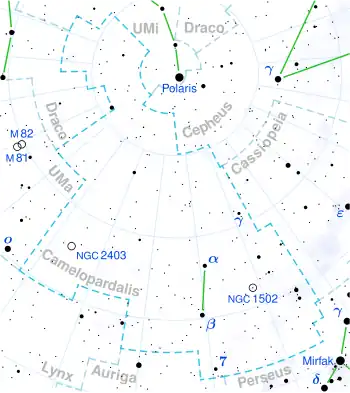 | |
| Observation data Epoch J2000.0 Equinox J2000.0 (ICRS) | |
|---|---|
| Constellation | Camelopardalis |
| Right ascension | 04h 04m 27.16294s[1] |
| Declination | +59° 09′ 19.8327″[1] |
| Apparent magnitude (V) | 5.12[2] |
| Characteristics | |
| Spectral type | F0 II[3] |
| U−B color index | +0.47[2] |
| B−V color index | +0.15[2] |
| Variable type | constant[4] |
| Astrometry | |
| Radial velocity (Rv) | −20.3±0.8[5] km/s |
| Proper motion (μ) | RA: −3.380 mas/yr[1] Dec.: +1.027 mas/yr[1] |
| Parallax (π) | 1.5558 ± 0.1047 mas[1] |
| Distance | 2,100 ± 100 ly (640 ± 40 pc) |
| Absolute magnitude (MV) | −3.91[6] |
| Details | |
| Mass | 8.78±0.65[7] M☉ |
| Radius | 50.1[8] R☉ |
| Luminosity (bolometric) | 9,878[7] L☉ |
| Surface gravity (log g) | 1.87[9] cgs |
| Temperature | 7,425[7] K |
| Metallicity [Fe/H] | −0.07[9] dex |
| Rotational velocity (v sin i) | 6.8±2[10] km/s |
| Age | 32[9] Myr |
| Other designations | |
| Database references | |
| SIMBAD | data |
HD 25291, also known as HR 1242, is a solitary,[12] yellowish-white hued star located in the northern circumpolar constellation Camelopardalis. It has an apparent magnitude of 5.12,[2] making it one of the brighter members of this generally faint constellation. The object is relatively far at a distant of approximately 2,100 light years[1] but is drifting closer with a heliocentric radial velocity of −20.3 km/s.[5]
HD 25291 has a general stellar classification of F0 II,[3] which indicates that it is an evolved early F-type bright giant. It has also been given a class of F2 Ia,[13] instead suggesting a slightly cooler and more luminous supergiant. Nevertheless, it has 8.8 times the mass of the Sun[7] but at an age of 32 million years,[9] it has expanded to 50.1 times its girth.[8] It radiates at a bolometric luminosity 9,878 times greather that of the Sun from its enlarged photosphere at an effective temperature of 7,425 K.[7] HD 25291 is slightly metal deficient, with an iron abundance 85% of solar levels.[9] It spins modestly with a projected rotational velocity of 6.8 km/s.[9]
Tetzlaff et al. (2011) found the object to be a runaway star with a peculiar velocity of 25.7+1.9
−4.1 km/s, which is high compared to neighboring stars.[14]
References
- 1 2 3 4 5 6 Brown, A. G. A.; et al. (Gaia collaboration) (2021). "Gaia Early Data Release 3: Summary of the contents and survey properties". Astronomy & Astrophysics. 649: A1. arXiv:2012.01533. Bibcode:2021A&A...649A...1G. doi:10.1051/0004-6361/202039657. S2CID 227254300. (Erratum: doi:10.1051/0004-6361/202039657e). Gaia EDR3 record for this source at VizieR.
- 1 2 3 4 Ducati, J. R. (2002). "VizieR Online Data Catalog: Catalogue of Stellar Photometry in Johnson's 11-color system". VizieR Online Data Catalog. 2237. Bibcode:2002yCat.2237....0D.
- 1 2 Gray, R. O.; Napier, M. G.; Winkler, L. I. (April 2001). "The Physical Basis of Luminosity Classification in the Late A-, F-, and Early G-Type Stars. I. Precise Spectral Types for 372 Stars". The Astronomical Journal. 121 (4): 2148–2158. Bibcode:2001AJ....121.2148G. doi:10.1086/319956. ISSN 0004-6256.
- ↑ Adelman, S. J.; Cay, I. H.; Cay, M. T.; Kocer, D. (September 2000). "On the Variability of A6 to F9 Supergiants". Information Bulletin on Variable Stars. 4947: 1. Bibcode:2000IBVS.4947....1A. ISSN 0374-0676.
- 1 2 Gontcharov, G. A. (November 2006). "Pulkovo Compilation of Radial Velocities for 35 495 Hipparcos stars in a common system". Astronomy Letters. 32 (11): 759–771. arXiv:1606.08053. Bibcode:2006AstL...32..759G. doi:10.1134/S1063773706110065. eISSN 1562-6873. ISSN 1063-7737. S2CID 119231169.
- ↑ Anderson, E.; Francis, Ch. (May 2012). "XHIP: An extended hipparcos compilation". Astronomy Letters. 38 (5): 331–346. arXiv:1108.4971. Bibcode:2012AstL...38..331A. doi:10.1134/S1063773712050015. eISSN 1562-6873. ISSN 1063-7737. S2CID 119257644.
- 1 2 3 4 5 Hohle, M.M.; Neuhäuser, R.; Schutz, B.F. (April 2010). "Masses and luminosities of O- and B-type stars and red supergiants". Astronomische Nachrichten. 331 (4): 349–360. arXiv:1003.2335. Bibcode:2010AN....331..349H. doi:10.1002/asna.200911355. eISSN 1521-3994. ISSN 0004-6337. S2CID 111387483.
- 1 2 Stassun, Keivan G.; et al. (9 September 2019). "The Revised TESS Input Catalog and Candidate Target List". The Astronomical Journal. 158 (4): 138. arXiv:1905.10694. Bibcode:2019AJ....158..138S. doi:10.3847/1538-3881/ab3467. eISSN 1538-3881.
- 1 2 3 4 5 6 Lyubimkov, Leonid S.; Lambert, David L.; Korotin, Sergey A.; Rachkovskaya, Tamara M.; Poklad, Dmitry B. (8 December 2014). "Carbon abundance and the N/C ratio in atmospheres of A-, F- and G-type supergiants and bright giants". Monthly Notices of the Royal Astronomical Society. 446 (4): 3447–3460. arXiv:1411.2722. Bibcode:2015MNRAS.446.3447L. doi:10.1093/mnras/stu2299. eISSN 1365-2966. ISSN 0035-8711.
- ↑ De Medeiros, J. R.; Alves, S.; Udry, S.; Andersen, J.; Nordström, B.; Mayor, M. (January 2014). "A catalog of rotational and radial velocities for evolved stars". Astronomy & Astrophysics. 561: A126. arXiv:1312.3474. Bibcode:2014A&A...561A.126D. doi:10.1051/0004-6361/201220762. eISSN 1432-0746. ISSN 0004-6361.
- ↑ "HR 1242". SIMBAD. Centre de données astronomiques de Strasbourg. Retrieved August 14, 2022.
- ↑ Eggleton, P. P.; Tokovinin, A. A. (11 September 2008). "A catalogue of multiplicity among bright stellar systems". Monthly Notices of the Royal Astronomical Society. 389 (2): 869–879. arXiv:0806.2878. Bibcode:2008MNRAS.389..869E. doi:10.1111/j.1365-2966.2008.13596.x. eISSN 1365-2966. ISSN 0035-8711.
- ↑ Hardorp, J.; Rohlfs, K.; Slettebak, A.; Stock, J. (1959). "Luminous stars in the Northern Milky Way. Part I.". Hamburger Sternw. Warner & Swasey Obs. C01: 0. Bibcode:1959LS....C01....0H.
- ↑ Tetzlaff, N.; Neuhäuser, R.; Hohle, M. M. (October 12, 2010). "A catalogue of young runaway Hipparcos stars within 3 kpc from the Sun". Monthly Notices of the Royal Astronomical Society. Oxford University Press (OUP). 410 (1): 190–200. arXiv:1007.4883. Bibcode:2011MNRAS.410..190T. doi:10.1111/j.1365-2966.2010.17434.x. ISSN 0035-8711.